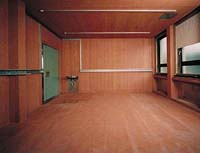Zalud Report: War of the Walls

He got really excited when we approached a business meeting room, that, after the door opened, looked like any other of hundreds of meeting rooms I’ve seen. “The walls,” he told me while patting the wallpapered surface, “contain shielding. The electrical outlets are specially protected and isolated. The telephones are specially wired to allow encryption devices.”

Economic Espionage
The special security wasn’t installed for monthly meetings of Tom Ridge’s top Homeland Security executives. Instead the meeting room’s extra protection provides a higher level of comfort for the clothes designers, media moguls and Wall Street powerhouses, all fearful of eavesdropping from competitors, overseas governments and maybe a New York prosecutor or two.Shielding started years ago, primarily as a way to protect electronic equipment from electromagnetic interference (EMI) and radio frequency interference (RFI) coming from other equipment and devices nearby.
The threat has turned back on itself, however. More often today, it’s the potential of intentional eavesdropping, invasions of privacy, data stealing, disruption of communications and even destruction of equipment and data, which have pushed shielded rooms from the Pentagon to hotel meeting rooms.
There are numerous ways organizations can protect themselves and at all types of price points.
There are TEMPEST computers and cabinets, with TEMPEST a government acronym for transient electromagnetic pulse emanation standard. Other strategies include protective glass, metal mesh, polymer and advanced coatings for wires and cabling, thermal spraying of metal construction surfaces, specialty wallpapers, as well as specially treated gypsum board, insulating sheathing, siding, vapor barriers and sheet metal roofing.
Cost and installation depend on the extent of EMI/RFI protection needed. It takes some skill and understanding to properly install many of the products. Take wire mesh. It must be installed on all walls, the floor and ceiling with each mesh panel overlapping another to guarantee effectiveness.
Eavesdropping Vans on the Prowl?
It is difficult to determine the potential extent of attacks and theft via EMI/RFI. During the Cold War, the U.S. military and intelligence community shrouded the threats and prevention measures under a classified blanket. Then and now, some folks see conspiracies with vans full of government agents roaming America’s streets as they eavesdrop on people in buildings. I remember writing years ago about the contention that the government had developed a high emission radio frequency or HERF gun that fires a beam of RFI to disable a vehicle or bring down a computer.There is no doubt, however, that on a less James Bond level, real threats exist. Good security not only provides protection, it should also provide comfort.
So if Tommy needs a shielded room to discuss how low those low-cut jeans will go next year, it’s a good thing.
Looking for a reprint of this article?
From high-res PDFs to custom plaques, order your copy today!







